The silence has been deafening since the Department of Sport released its public consultation document on the desirability of placing a further 14 sports events on the free-to-air television list. That silence should not be taken as indifference on the part of affected sports organisations, as will become apparent when the submissions start hitting the Minister’s desk.
Nothing has been decided but it’s certain that the GAA will have strong views on the proposal effectively to devalue its media rights. Croke Park clearly wasn’t keen to engage in a public spat on the subject, but the idea that so many of Gaelic games’ highest profile matches should be ring-fenced against competitive bidding will draw a response.
The schedule affects a few sports, notably soccer and rugby as well as women’s Gaelic games and many are already free-to-air. Included from a GAA perspective are All-Ireland semi-finals and quarter-finals as well as provincial finals.
For a long time former director general Liam Mulvihill routinely lamented the lack of a competing broadcaster for RTÉ, and how that militated against the GAA getting a fair price for its matches. That was eventually addressed by the arrival of Setanta, TV3, now Virgin Media, and later Sky Sports, but by the 2022 rights issue the association deemed its best move was the allocation of rights to GAAGO, the joint streaming operation with RTÉ, previously used to service the overseas audience.
READ MORE
To provide competition there has to be the offer of some attractive fixtures. Last year two out of six All-Ireland quarter-finals were carried on GAAGO and the six provincial finals were all on RTÉ.
According to the department’s press release the rationale was about balance. “The aim of designating events as free-to-air is to try to balance the rights of the sporting bodies to exploit commercial opportunities afforded by their broadcasting rights and the needs of society to engage, as a whole, with culturally significant events, which act as a focal point for society and create a sense of national identity and pride.”
Up to a point. Categorising the generally reviled provincial football finals as “culturally significant events” might be stretching things – unless Unesco grants special cultural status to turkey shoots as well as hurling. It also emerged that the public view of football’s provincial finals might not be as elevated as none of them made the top 30 sporting broadcasts.
Once again the primacy of big international sporting occasions was underlined as just the All-Ireland finals plus the Dublin-Monaghan semi-final and Dublin-Mayo quarter-final featured in the top 20 most-viewed sports broadcasts.
Rugby dominated ratings in a year that saw Ireland win the Grand Slam and go to the World Cup as one of the contenders. The initial thought that this might be a commentary on the new GAA season with its compressed calendar and July All-Irelands was dispelled by the actual numbers.

The audience for Dublin-Kerry came in at just under a million (977,000), which wasn’t far off the counties’ previous final and replay in 2019, both of which were big enough (988,000 and 991,000) to be the second and third most watched programmes of the year. Last year that was only good enough for sixth place.
By coincidence Dublin and Kerry have been in the football final the same year as the last four rugby World Cups and scored much the same ratings, with only 2015 dropping below 900,000.
In a broader context the proposal to extend the free-to-air designation can be seen as the latest intrusion by Government into the GAA’s commercial affairs. Tánaiste Micheál Martin has been to the fore in recent months. This has come as a surprise given his uncontrived interest in the association and its games. As taoiseach during the pandemic his support was very valuable for the GAA in getting the winter championship funded in the absence of spectators.
In the past 12 months, though, the Tánaiste’s interventions have been less welcome back to his “creeping paywall-ism” comments at the height of the GAAGO controversy in the context of the Limerick-Clare and Cork-Tipperary hurling matches being exclusively on the GAA-RTÉ streaming service.
Further to his opposition he suggested that his namesake, media minister Catherine Martin, look at extending the list of protected events, a process her department said at the time was already under way and which last week produced the current proposals.
Last week this was followed by Mr Martin’s strong reaction to the naming rights issue in Cork and the prospect of SuperValu Páirc replacing Páirc Uí Chaoimh – a topic on which he again felt strongly as it involved the memory of Padraig Ó Caoimh, a founding member of the Tánaiste’s club Nemo Rangers.
Is the point that stadium naming rights have to be approved by government or by the GAA itself? Are these general principles or only applicable in Cork?
As it turned out the unhappiness was widely shared, and the original plan looks unlikely to proceed on the basis that the county committee has not been persuaded.
[ Some things can’t be sold, but is Páirc Uí Chaoimh one of them?Opens in new window ]
[ Páirc Uí Chaoimh Q&A: All you need to know about naming rights controversyOpens in new window ]
Taken together these warnings on how the GAA exercises it commercial freedom must be a concern for Croke Park. There is no point in rehashing the arguments over GAAGO beyond pointing out that media rights are an important part of the association’s revenue stream.
The main income source is gate receipts, last year worth €33.4 million or 35 per cent of total income. Commercial is next with €22.4 million, the biggest share of which (€15.3m) is made up of media coverage.
Unless, of course, Government wants to compensate sports organisations for their reduced competitiveness. Otherwise all of the support they receive is simply giving with one hand while taking with the other.
















